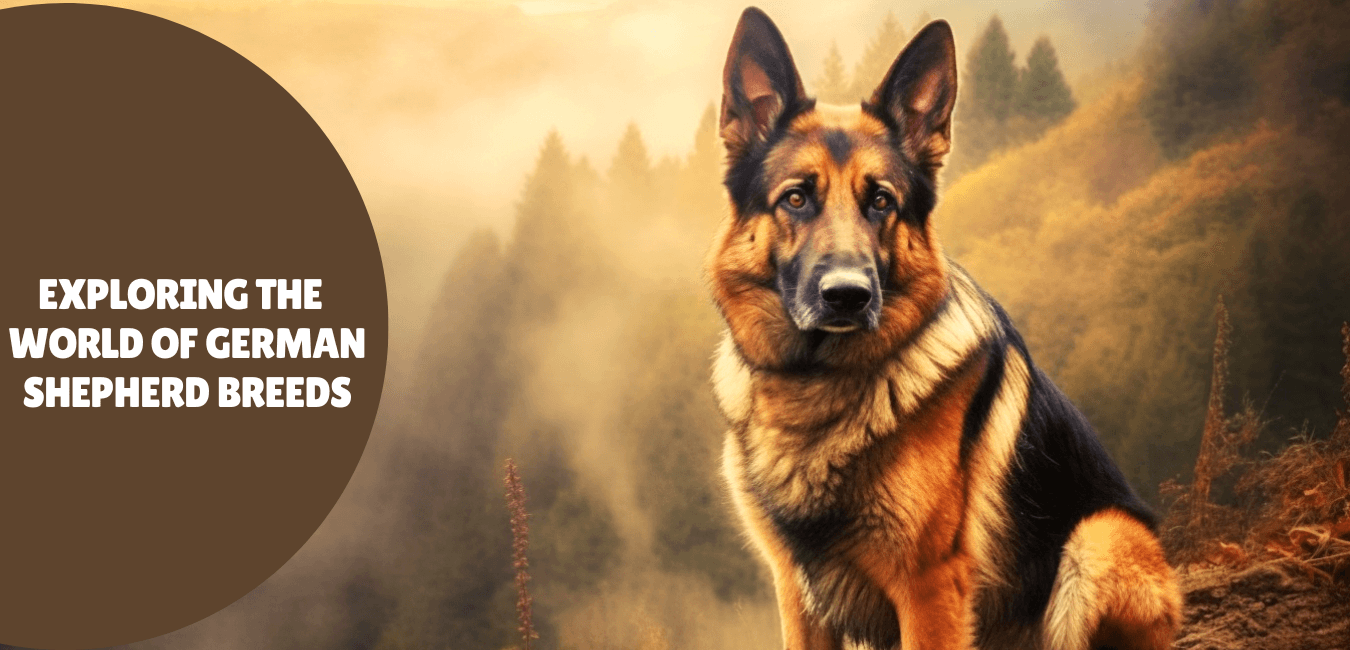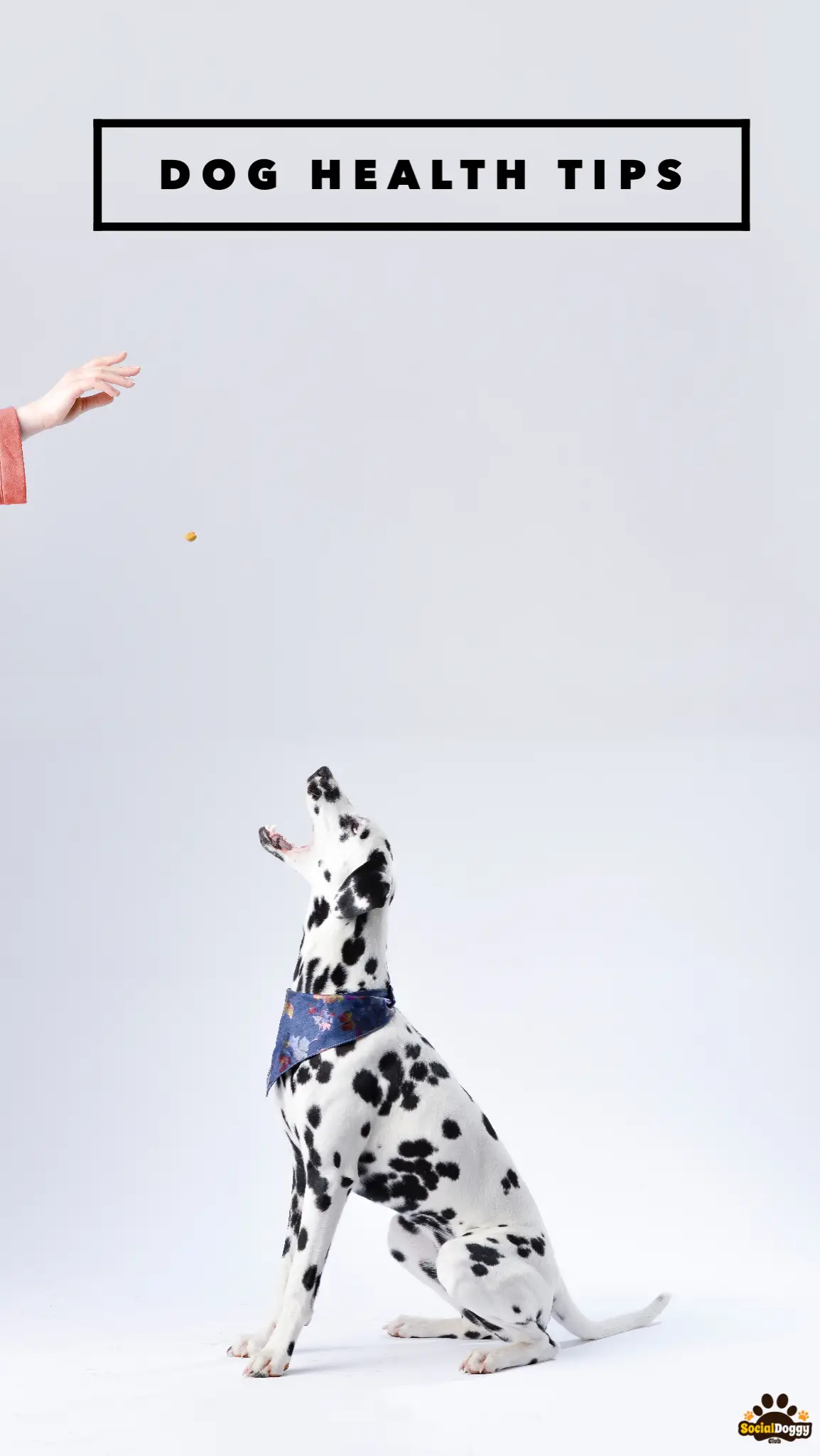German Shepherds are well-loved for their brains, loyalty, and protective nature. These amazing dogs were originally bred to herd, but their trainability has made them successful in many endeavors such as performance sports, law enforcement, and the military. They come in different coat varieties and colors, each with its own personality and temperament.
These impressive pups have a well-muscled body, attentive ears, and alert eyes that make them an iconic breed. Even though they’re larger than other breeds, German Shepherds are agile and flexible, and they excel in various activities, like obedience trials or search-and-rescue missions.
German Shepherds have been serving humanity for centuries. For instance, during WWI, they carried supplies on the battlefield. During WWII, they worked with the U.S Military and the Red Cross to detect landmines and gas leaks. Nowadays, these incredible breeds continue to show their capabilities in various roles, such as companion pets for people with disabilities.
German Shepherds are the perfect combination of athleticism and fluffiness. They’re the ultimate furry fitness coaches!
Contents
Physical Characteristics of German Shepherds
To explore the physical characteristics of German Shepherds, you can take into account the size, weight, coat, and color of this fascinating breed. Additionally, the facial features and body structure of German Shepherds are key aspects to consider. Discover the unique traits that make German Shepherds stand out among other breeds.
Size and Weight
German Shepherds: Knowing Their Size and Weight
German Shepherds are intelligent, courageous, and loyal. When it comes to their size and weight, they’re robust animals. They can reach up to a considerable height and mass.
Here’s a table for specific info on their size and weight based on gender:
| Gender | Height (inches) | Weight (lbs) |
|---|---|---|
| Male | 24-26 | 65-90 |
| Female | 22-24 | 50-70 |
Males are generally bigger than females. But both genders have strong builds. German Shepherds have an elongated head with pointy ears that stand upright. Their eyes are wide-set and deep brown.
Captain Max Von Stephanitz developed this breed in Germany during the late nineteenth century. He wanted a working dog with intelligence, athleticism, and obedience.
Knowing German Shepherds’ physical attributes is essential for pet owners. They’ll remain valued members of many families around the world, due to their beauty and personalities.
No matter the color, German Shepherds shed the same amount!
Coat and Color
The Physical Characteristics of German Shepherds are quite impressive. Especially when it comes to Coat and Color. A Table below shows the different options. It can vary from dog to dog.
| Coat and Color | Description |
|---|---|
| Black and Tan | Black saddle on a tan body |
| Sable | Dark fur with black tips |
| Bi-color | Black saddle on a light body |
| Panda | White fur with black spots |
Plus, different hair lengths and textures like rough or smooth coats can occur. And colors may vary for each coat type.
The history behind German Shepherds’ Coat and Color is believed to be selective breeding by Captain Max von Stephanitz. He wanted a recognizable looking and versatile working dog. But, breeders have kept true to the original design. German Shepherds have such impressive features, they could be models for marble sculptures!
Facial Features and Body Structure
German Shepherds boast distinct features that add to their physical appeal, like their pointed muzzles, dark eyes, and upright ears. They have a muscular body structure, powerful hindquarters, and deep chest that make them agile and ready for action.
The wedge-shaped head of a German Shepherd is what sets them apart from other breeds. They have a strong jawline and a slim neck, perfect for carrying things or carrying out search & rescue missions. Their limbs are perfectly proportioned to their body length, making them super athletic.
They have a double-coated fur that can adapt to any climate. The outer coat is black, sable, or tan, while the inner coat is thick, keeping them warm and dry in wet/cold weather.
German Shepherds are incredibly intuitive when it comes to people they know. But they can also be protective towards strangers who wish to hurt their owners. There are famous stories of how these dogs saved lives by stopping criminals mid-escape, or working as therapy dogs for those in emotional distress.
Police K-9s love German Shepherds because of their loyalty and versatility. With proper training, they can do so many jobs, such as tracking down fugitives, working on farms, and being good companions in households.
German Shepherd Personality Traits
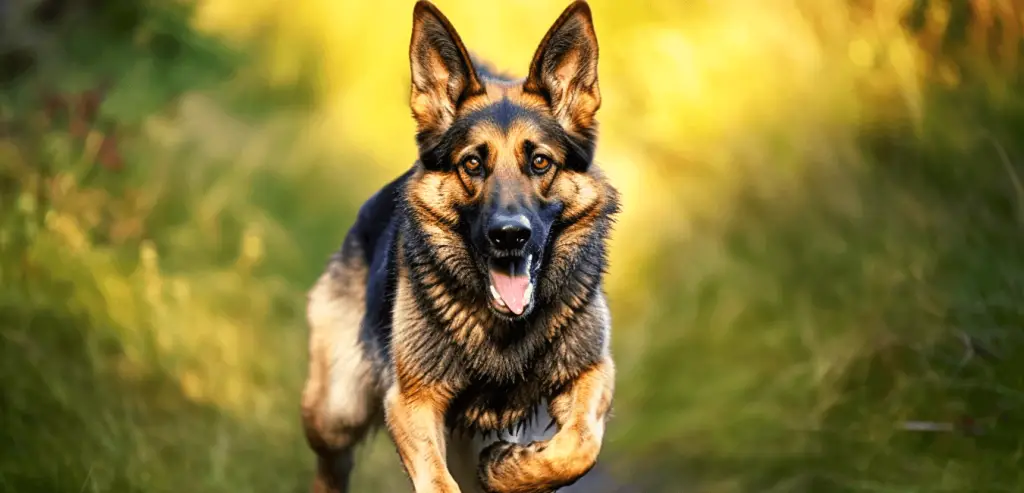
To explore German Shepherd personality traits in detail, the following sub-sections will highlight the solutions for intelligence and trainability, loyalty and protective instincts, and energy levels and exercise requirements. Understanding these traits will enable you to know what to expect from your furry companion and how to care for them appropriately.
Intelligence and Trainability
German Shepherds have an amazing ability to learn and obey commands. They quickly comprehend new tasks and are thrilled to make their owners proud. With the right training, they can be great at activities like obedience, agility, and search and rescue.
They have an intelligent mind that helps them understand concepts quickly. They also have great problem-solving skills and they can use what they know in real-life situations. As social animals, they love being part of the family and they love getting positive feedback. Training needs to be regular and reward-based for the best results.
These dogs are naturally protective of their home and family. This makes them great guard dogs, but it can lead to aggression if not taught properly. Socialization is key for avoiding this.
As reported by the AKC, German Shepherds were the second most popular dog breed in 2020, showing their worldwide appeal. German Shepherds are like a furry security system – always devoted and ready to shield their family.
Loyalty and Protective Instincts
German Shepherds boast an innate devotion and instinct to protect their loved ones. This is their unwavering loyalty and guard-dog mentality, which sets them apart from other breeds in terms of trustworthiness and reliability.
They have an acute sense of awareness, making them superb police dogs, search-and-rescue workers, and watchdogs. They’ll willingly jump into harm’s way to shield their family or property.
Their loyalty doesn’t end there. German Shepherds also love and respect their owners deeply, forming a family-like bond. They desire companionship and can suffer from separation anxiety if left alone too often.
Since they’re intelligent, training them early is essential. Otherwise, they may become bored or frustrated and show destructive behavior. Exercise and daily activities like walks or runs will keep them both mentally and physically fit.
In conclusion, the unique combination of loyalty and protective instincts make German Shepherds an ideal choice for a trustworthy companion dog. Owners must be aware of these traits to ensure proper care and help the dog reach its full potential.
Energy Levels and Exercise Requirements
German Shepherds are known for their high energy levels and exercise needs. Walks, hikes, and runs can all help meet their activity demands. Plus, interactive toys and games give mental stimulation.
Exercise varies depending on age, level, and health. To keep boredom at bay, mix up activities and provide a stimulating environment. Exercise is essential for keeping German Shepherds happy and healthy.
History and Origin of German Shepherds
To understand the history and origin of German Shepherds, and to gain insight into their amazing journey, explore the sub-sections of their origin in Germany, role in World War I and II, and evolution of breeding standards. Each of these unique aspects highlights the incredible qualities and characteristics that make German Shepherds such a beloved and fascinating breed.
Origin in Germany
German Shepherds are an incredible breed originating in Germany in the early 20th century. They were bred to be intelligent, agile and versatile. Plus, their loyal and protective nature made them popular as police and service animals.
Rin Tin Tin, a German Shepherd rescued from a WWI battlefield, went on to become a Hollywood star. This raised worldwide awareness of the breed.
These pups remain popular due to their intelligence, loyalty and versatility. They are obedient, quick learners and have self-confidence. Plus, their coloring variations make them look unique!
German Shepherds have saved countless lives over the years. From Sergeant Stubby in WWI to modern police dogs sniffing out drugs and explosives, they never cease to amaze!
Oh, and let’s not forget their legendary grenade fetching skills!
Role in World War I and II
During World War I and II, German Shepherds made a huge impact due to their loyalty, intelligence, and strength. They were trained in various tasks, such as carrying messages, locating injured soldiers, detecting mines, and being guard dogs.
These amazing qualities made them popular with the military and law enforcement. After the wars, they gained worldwide recognition for their help.
They are also great for search and rescue, police work, and helping people with disabilities. Their intelligence and versatility make them an ideal breed.
If you’re thinking of adopting a German Shepherd, make sure you have enough time to train and exercise them. Physical activity is important to keep them mentally and physically fit. Getting help from a professional trainer will help you form a great bond.
Although the breed has changed over time, their loyalty and protectiveness has stayed the same.
Evolution of breeding standards
The breeding standards of German Shepherds have advanced over time. To appreciate the breed, it’s worth learning about its evolution. Initially, intelligence, agility, and sociability were emphasized. Later, athleticism, looks, and specialized skills were added.
The table below shows the physical traits of the different phases:
| Breeding Phase | Physical Characteristics |
|---|---|
| Original Breeding | Intelligence, Sociability and Agility |
| Modern Domesticated Breeding (Appearance Emphasis) | Symmetrical Size, Athletic Build, Focus on Black/Tan Colors. |
| Police & Military Breeding (Specialized Training Emphasis) | Dense Muscular Build, Acute Agility for Skills Training. |
More rigorous tests have validated the new traits. For instance, the AKC requires hip evaluations before breeding.
For a good companion or protector, ask about breeder certifications before buying puppies. Remember, dogs are life-time friends. From long-haired to short-haired, German Shepherds come in all shapes – just like your exes!
Types of German Shepherds
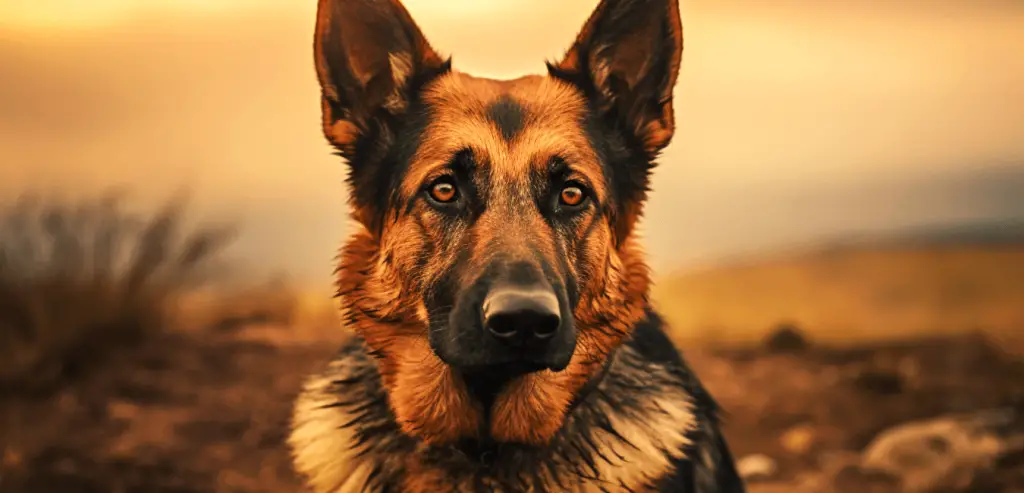
To explore the fascinating world of German Shepherd breeds, dive into the section on types of German Shepherds. If you’re curious about the distinct qualities of Working German Shepherds, Show German Shepherds, or American German Shepherds, this is the section for you.
Working German Shepherds
German Shepherds bred for work are highly desired. They are smart, loyal and flexible. Military and police use them for tasks like finding criminals or explosives and drugs. Working line German Shepherds differ in their physical traits. They are notably more active and athletic than show lines.
These dogs make great watchdogs due to their natural protective nature. People who want one should look for a reputable breeder that knows how to breed good-tempered German Shepherds.
What really sets working German Shepherds apart is their hardworking nature and drive to please their owners. They need regular exercise and mental stimulation to stay healthy. Activities like agility, herding, or obedience classes can help them develop and stay happy.
These dogs can make great family pets, but their high energy levels might not suit some households. They thrive in environments that challenge them physically and mentally. Make sure to check for health checks on hips and elbows. They need lots of love, patience, and attention – but it’s worth it for the many benefits they offer. Even if they don’t win Best in Show, Show German Shepherds can still captivate everyone’s hearts.
Show German Shepherds
Uncovering the Varieties of German Shepherds.
Four types of Show German Shepherds are noteworthy.
- Classic – tall, straight-backed. Great for shows, but prone to joint issues.
- West German – Showline. Sloping backs. Rich coat pigment. Lighter bone structure.
- American – Straight backs. Long necks. Almond-shaped eyes. Muscular hindquarters.
- Czech – Working Campus. Highly intelligent. Excel in protection dog sports. Big heads. Long coats. Athletic.
Despite the differences, all German Shepherds have loyalty and trainability in common – making them the best companions!
Don’t forget: Before breeding or competing with your German Shepherd, ensure that it meets the AKC breed standards for health testing.
American German Shepherds
American German Shepherds are unique in their looks and personality. They have great athleticism and energy, which makes them excellent working dogs. They have a straighter back than their European cousins.
They’re often bred as companions and family pets. They’re devoted to their owners and make great watchdogs. Plus, they’re clever and easy to train, making them great for service tasks like K9 units or search and rescue teams.
These German Shepherds have starred in many Hollywood movies due to their intelligence and appearance. An iconic example is Rin Tin Tin, who became a famous canine actor after his success on the silver screen.
All in all, American German Shepherds are a special breed with many impressive qualities. They make great pets, watchdogs, and service dogs.
Health Issues in German Shepherds
To ensure your German Shepherd is healthy, it’s important to be aware of potential health issues. In order to address this, we delve into the fascinating world of German Shepherd breed health issues. From hip and elbow dysplasia to gastric torsion and panosteitis, we will explore the different health concerns that German Shepherds may face.
Hip and Elbow Dysplasia
Canine hip and elbow conformational dysplasia is a common problem for German Shepherds. This degenerative disorder is caused by an improperly developed joint socket. It can lead to painful osteoarthritis, lameness, and immobility.
The severity of the dysplasia can range from mild to severe. Mild cases may not need medical attention, whereas moderate-to-severe cases may need surgery or medication. Genetics is a significant contributing factor.
Preventative measures such as maintaining a healthy weight, doing low-impact exercises, and avoiding excessive jumping and running can help reduce the risk of dysplasia.
Surprisingly, dysplasia can also be caused by physical stress, such as intense exercise before full growth.
Source: American Kennel Club. Looks like German Shepherds can’t ignore the phrase ‘you are what you eat‘ – especially when it comes to gastric torsion.
Gastric Torsion
Canine bloat is a serious health issue in German Shepherds. It can lead to GDV, when the stomach twists and fills with gas. This restricts blood flow and harms internal organs. It’s life-threatening and needs urgent medical care.
Signs of GDV include restlessness, vomiting, swollen belly, shallow breathing, and pale gums. Eating large meals, exercising after eating, stress, or anxiety can increase the risk. Emergency surgery is the only effective treatment.
It’s possible to reduce the chance of canine bloat in German Shepherds. Feed smaller meals, avoid strenuous exercise after feeding, and watch for signs of sickness or discomfort.
Pro Tip: Vet care is essential to stop complications from canine bloat in German Shepherds. Quick diagnosis increases the chances of successful treatment and recovery. Additionally, Panosteitis is a painful bone disease for German Shepherds.
Panosteitis
A bone disease commonly affecting German Shepherds is a painful condition. It’s called osteochondrosis and causes soreness, lameness, and inflammation in young dogs’ growing bones. This condition usually affects the femur, radius, and ulna of 5 – 14 month old pups.
Diagnosing panosteitis is tricky, as its symptoms are similar to other conditions like hip dysplasia or arthritis. To rule these out, vets use radiography, blood tests, and physical exams. Treatment often includes non-steroidal anti-inflammatory drugs (NSAIDs) to ease pain during acute flare-ups.
Interestingly, panosteitis can come and go in cycles of several weeks or months. Hormonal imbalances may be a factor, but there is still more research to be done. In the past, vets often incorrectly treated this condition with surgery. Nowadays, the right treatment is available if vets can diagnose it quickly.
Training a German Shepherd may seem impossible, but with commitment, you’ll have a devoted buddy who won’t let you down.
Training and Care for German Shepherds
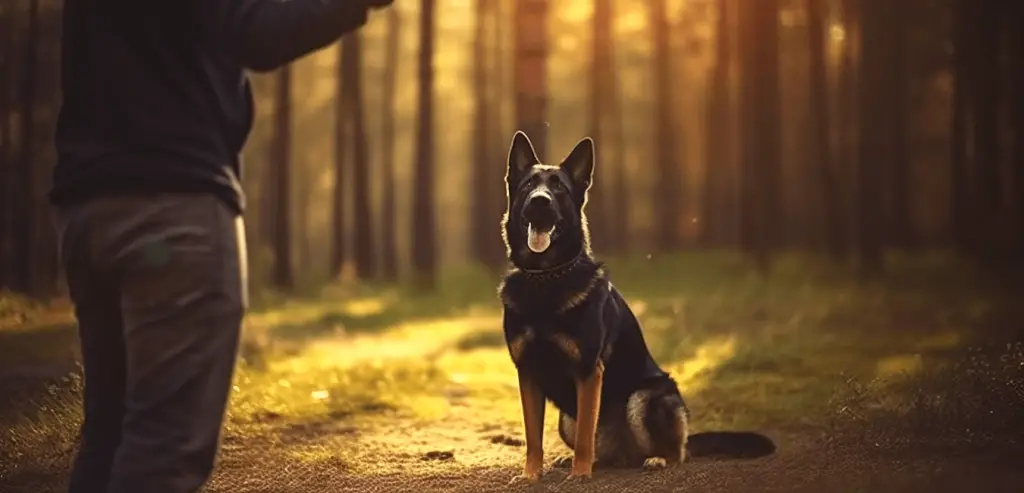
To effectively train and care for German Shepherds, you need the right knowledge and techniques. For this section on training and care, we present you with the solutions that’ll help you take good care of your furry friend. We’ll look at basic obedience training, socialization and behavior training, grooming, and health care.
Basic obedience training
Train German Shepherds to obey basic commands, like “Sit,” “Stay,” “Come,” and “Heel.” Establish a strong relationship between pet and owner. Here’s a 5-Step Guide:
- Start with simple orders.
- Use positive reinforcement, like treats or compliments.
- Make it more difficult as they learn.
- Use hand signals too.
- Be consistent.
Not all pups learn at the same rate, so be patient. Some need special training depending on their character or past events. Pro Tip: Use positive, patient behavior. Positive reinforcement works best – don’t use negative reinforcement, which can make them aggressive. Obedience training is hard but essential.
Socialization and behavior training
Socializing and modifying behavior is key to raising a well-behaved, emotionally balanced German Shepherd. This means exposing the pup to different environments, people, and other animals. And teaching them how to handle reactions. Training must be consistent to stop unwanted behaviours like aggression or barking.
A strong obedience program helps the pup have a positive attitude towards learning. And master commands like ‘sit’, ‘stay’, ‘come’ etc. Behavioral training involves desensitizing them to things that may trigger anxiety or fear. But do it gradually and in small doses.
When the pup does something good, reward it with praise, treats or petting. This reinforces good habits. Every dog is different, so some need extra care. Remain patient and firm while guiding them. Experienced trainers are best for German Shepherds.
My friend had a GSD pup that was inactive and nervous due to not being exposed to new experiences. They got advice on how to socialize her. And eventually, she became more confident. They have a better bond after consistent training sessions.
Treat your GSD to a spa day, but getting them to sit still for a pedicure is tough.
Grooming and health care
Looking after your German Shepherd is key! This breed needs a special grooming schedule to keep them healthy, content and clear of skin and coat difficulties. Here are 3 tips for giving your cuddly pal the best grooming and health care:
- Brush them often to stop tangles in their double coat and help spread natural oils that create a glossy coat.
- Clip their nails every 3 weeks to avoid overgrown nails, which can be painful and cause problems while walking.
- Clean their ears and teeth frequently to protect from ear infections, bad breath, gum disease, or tooth decay.
Also, note that too much bathing can strip away essential oils from their coat, causing dryness and itchiness.
German Shepherds are known for having tender stomachs that can react to allergies and cause digestion issues. If this happens, take them to a professional vet.
Jack once took his German Shepherd to be groomed; there he met a pro pet groomer who advised trimming the fur around the dog’s paw pads. Jack was hesitant at first, but later noticed how much easier it was for his pup to walk on even surfaces. The trimmed fur gave more grip, stopped slipping and eliminated dirt build-up between the paw pads. Since then, Jack’s included regular trimming in his grooming routine, with great results!
German Shepherds are the true celebs of pop culture – excluding Gerard Butler’s abs in ‘300’ of course!
German Shepherds in Pop Culture
To explore German Shepherds in pop culture with a focus on famous portrayals in movies, TV shows, and books. Delving into these sub-sections will highlight how German Shepherds have been utilized as a beloved and popular breed for various forms of media throughout the years.
Famous German Shepherds in Movies
German Shepherd Dogs – the superstars of the silver screen! These intelligent and adaptable pooches have won many hearts. Let’s take a look at some of the most iconic German Shepherds in movies.
- Rin Tin Tin – This pup was rescued and brought to fame for his bravery and acting skills.
- Strongheart – Another rescue from Germany, he was one of the first canine movie stars.
- Lobo – Played a fiercely loyal sheepdog in “The Adventures of Lobo”.
- Max – Featured in “Max” for his bravery during the war.
- Ramses – Became a hero in “Without Warning”, saving lives as a guard dog.
- Rex – Showcased his scent tracking abilities in “Police Dog Story”.
Not only are German Shepherds great actors, they have a rich history too. They were used by Germans in WWI for their loyalty and work ethic. Since then, they’ve been used as police and military dogs around the world.
Pro Tip: German Shepherds are loving and loyal but need proper training and socialization for them to be great companions. Can these famous four-legged friends make it as literary stars too?
German Shepherds in TV Shows and Books
German Shepherds have made a big impact on the entertainment industry. Known for their intelligence, loyalty, and versatility, they have become a popular character type in pop culture.
TV shows like K-9 Unit and Police Dog feature these working dogs, while children’s books like Walter the Farting Dog show their loving nature.
In thrillers like John Wick 3: Parabellum, German Shepherds are fierce protectors who won’t back down from any enemy.
Max from A Dog’s Purpose, Bailey from A Dog’s Journey, and real-life Rin Tin Tin (with an Academy Award!) have all become cultural icons due to their personalities.
The perfect breed for those who want a loyal companion and a one-dog police force? German Shepherds!
Conclusion: Why German Shepherds are Fascinating Breeds.
German Shepherds are amazing! They have many unique qualities. People love them for their trainability and loyalty. Plus, they are strong and agile, making them great working dogs. They help protect homes, law enforcement, and search and rescue operations.
Their sense of smell is excellent and they have lots of energy. This makes them one of the most versatile breeds around. And, their intelligence means they can learn to do almost anything. From helping people with disabilities to joining the military.
German Shepherds are also loving and get along with people of all ages. Their history is amazing too. People all over the world adore them. Did you know that Rin Tin Tin was a German Shepherd? He was rescued from a bombed-out kennel in France during WWI. He even starred in over 27 films!
For all these reasons, German Shepherds remain one of the most popular dog breeds.
Frequently Asked Questions
1. What makes German Shepherds different from other breeds?
German Shepherds are known for their intelligence, loyalty, and protective instincts. They are often used as police dogs, search and rescue dogs, and as service animals. They have a strong work ethic and are quick learners.
2. Are German Shepherds good with children?
Yes, with proper socialization, German Shepherds can be great family pets and are known for being great with kids. They are very protective of their family, which can make them great watchdogs as well.
3. What health issues do German Shepherds often face?
Numerous health problems, including hip dysplasia, elbow dysplasia, and intestinal problems are common in German Shepherds. To identify any potential health issues early, it’s critical to choose a trustworthy breeder and maintain frequent veterinary examinations.
4. How much exercise do German Shepherds need?
German Shepherds are very active dogs and need daily exercise to stay healthy and happy. They enjoy long walks, runs, and playing fetch. They also excel at more structured activities such as obedience training or agility courses.
5. Are German Shepherds aggressive?
German Shepherds can be trained to be aggressive if their owners desire it, but they are not naturally aggressive dogs. They are protective of their family and can be wary of strangers, but with proper socialization, they can be well-behaved around new people and other animals.
6. How do I find a reputable German Shepherd breeder?
It is important to do your research and find a breeder who cares about the health and wellbeing of their dogs. Look for breeders who perform health screenings on their dogs and who can provide references from previous buyers. You can also contact breed-specific rescue organizations for recommendations on reputable breeders.

